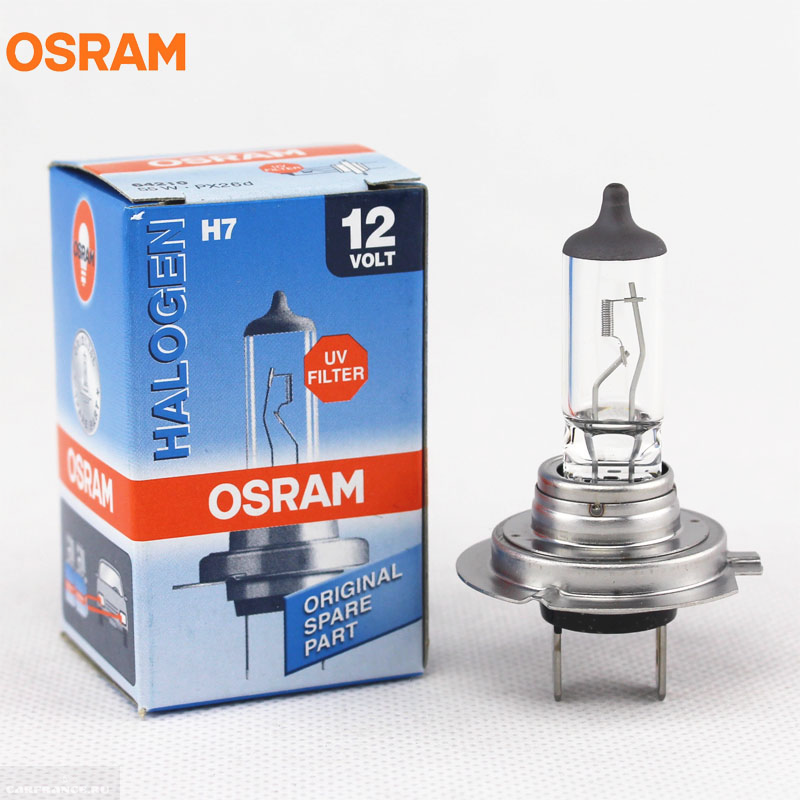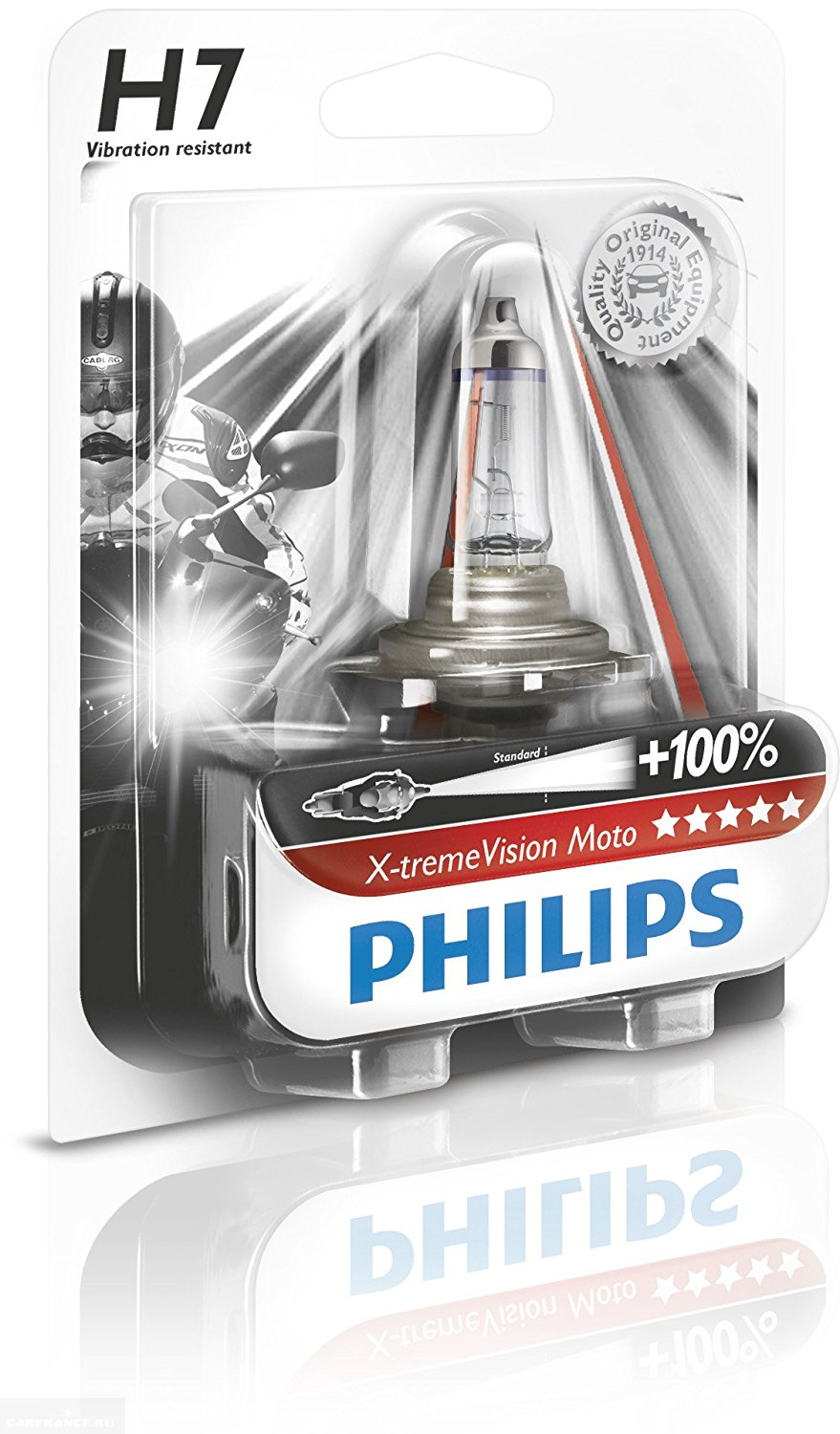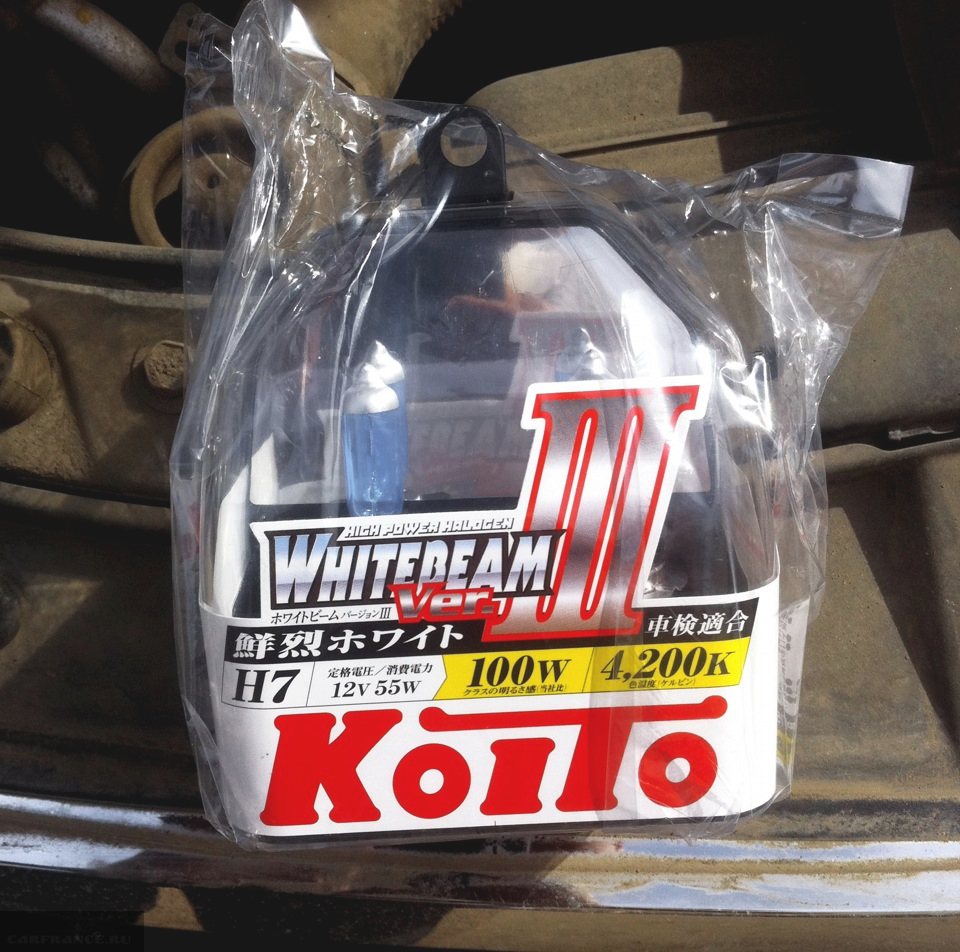And God said: let there be light.
And there was light.
And God saw the light that it was good, and
God separated the light from the darkness.
And God called the light day and the darkness night.
(Genesis 1:1-4).
And no matter what Sergey Lukyanenko writes in his books, the history of the world began in this way, and nothing else. And if people will rack their brains over what preceded the events described in 4 lines of the epigraph until the end of time, then we know what happens after them quite well.
According to legend, Prometheus was the first to enter the field of struggle for a brighter future for mankind: having snatched a spark from Olympus, he gave people fire. Further events developed in a light twilight, so history is silent about the copyright for a torch, a candle, a torch and a simple oil lamp. But, according to our data, any savvy altruist from the dim past could come up with it.
But many, many years later, the Russian inventor Ivan Kulibin assembled the first searchlight (“lantern of exceptional power”), which increased the strength of the light of a candle by 500 times. Then the French engineer Philippe Lebon designed the first gas lamp. And already in the 19th century, light sources fell on humanity like from a cornucopia: Yablochkov’s “candle” (Pavel Yablochkov), incandescent charcoal lamp (Alexander Lodygin), the first electric lamp (Joseph Swan), modern incandescent lamp (Thomas Edison), the first Fluorescent Lamp in the USSR (Sergey Vavilov), the first LED (Nick Holonyak).
So, in three short paragraphs, we were able to lay down almost the entire history of light in order to proceed to the main thing. And the main thing today will be automotive lighting. And this is where we start with evolution, with the evolution of light sources used on cars.
And we will make the first time travel to the very beginning of the 20th century.
Go!
YESTERDAY
Europe, 1909 A new world speed record has been set. A Benz car has developed a maximum speed of 205.7 km / h on a kilometer segment. A few years earlier, in the Paris-Madrid races, the cars covered a 500-kilometer distance at an average speed of 90 km / h. Thus, it became clear that the car caught up and overtook the horse, automatically transferred it from the category of the main vehicle to the category of transport anachronism.
The development of regular high-speed car traffic, not only during the day, but also at night, put forward the problem of lighting the way at night. The problem was solved by installing searchlight-type lamps, the light source in which was an acetylene lamp.
The installation of an electric starter on cars complete with a battery and, of course, a generator became the starting point for the evolution of automotive light. This significant event took place in 1912 and indirectly served as a pretext for the subsequent replacement of the chemical light source with an electric one. A year later, a gas-filled incandescent lamp with a high overall brightness was invented and thus opened the era of headlights with an electric light source.
In the era of scientific and technological progress, discoveries and inventions were made almost every day. Therefore, we are going to the 20s of the twentieth century, so as not to miss anything interesting.
TODAY AND TOMORROW
The transition from acetylene light sources to electric ones took place gradually. There was no hurry to put electric headlights on cars with gas burners. Refurbishment cost a pretty penny. But by 1925, when the electrical system became a mandatory accessory for all manufactured cars, the red-hot spiral of the light bulb finally forced out the fluttering tongue of burning gas from the headlights.
Experimenting with the design, the engineers came to conclusions about the fundamental geometric parameters of the lamps, in particular that for good lighting at long distances, the filament should be small. Also, all the nuances of the location of the light source in the headlight were finally clarified.
Over time, the simplest lamps were refined, and by the middle of the 20th century, the so-called European and American light distribution systems appeared (they differ in the shape and location of the dipped beam filament), Bilux double-filament lamps, halogen lamps, lamps of standards H1, H2, H3, H4, etc.
We still use the family of H-standard lamps, with the possible exception of H2, which is too complex in design and has not found wide application.
Today, many dream of xenon and bi-xenon. But now it’s not about that, but about why the title unites the present and the future.
At the moment, it is known that LEDs will take the place of the light source in the headlight of tomorrow (and in some places have already taken it). Therefore, the prospects here are no longer vague. They are quite visible even without time travel: there will be diodes!
ABOUT THE TEST
But while this is only tomorrow, we will have to be patient and wait, looking at what we have at the moment. In other words, let's evaluate the quality of the lamps that will have to light our way while waiting for the LED beams.
Your attention is the test of H7 lamps (dipped beam and high beam), which can be found in every store.
About the methodology low beam test
We do such tests not for the first and not even the second time. Taking into account the experience of previous publications, we decided to abandon some items of the test program. Of course, they are useful from the point of view of determining the quality of the product, but they are of practical value only for specialists. It is important for us to find out how and where the lamp shines, and not how it looks (in fact, this is closely related, but only a professional will distinguish the right lamp from the wrong one by eye).
A specialist can preliminarily determine the quality of a passing beam lamp by marking alone and appearance plinth and flask. Therefore, the primary analysis was carried out in the first 20 minutes, and then we checked the theoretical data obtained in practice.
So, the main points of our program for today: measuring the magnitude luminous flux lamps, measurement of power consumption and test results in the passing beam (headlight).
Light flow is a quantity characterizing the power of optical radiation.
Luminous flux rate (according to GOST): 1350-1650 lm (lumen).
Power- a value characterizing the consumed electrical power of the dipped beam lamp.
The maximum allowable power value is 58 W. If this figure is exceeded, the power supply system will be overloaded, which can lead to overheating of the wiring and melting of the connectors.
The test in the headlight (dipped and main beam) involves measuring the intensity of the light flux at 5 strictly defined control points and determining the cut-off line.
TECHNICAL SPECIFICATIONS
CONSUMER ANALYSISThe marking on the lamp fully complies with regulatory documents. The experts have already reacted with interest to the promised +30% light of this Vision Plus. SUMMARY |
Philips Vision Plus +50% |
TECHNICAL SPECIFICATIONSCar headlight lamp
CONSUMER ANALYSISThe marking on the lamp fully complies with regulatory documents, so the laboratory staff this stage no questions arose. The only thing that made the experts think was the promised Phillips Vision Plus + 50% light. What kind of light the manufacturer had in mind remained a mystery. SUMMARY |
TECHNICAL SPECIFICATIONSCar headlight lamp
CONSUMER ANALYSISThe marking on the lamp fully complies with regulatory documents, however, the lamp base alerted the specialists. In general, it is made neatly, but four symmetrically located dark dots in its lower part led the laboratory staff to think about a fake. Now let's see how OSRAM performs in the tests. SUMMARYand expert opinions on H7 low beam bulb |
TECHNICAL SPECIFICATIONSCar headlight lamp
CONSUMER ANALYSISThere are no European certification marks, but the packaging has a Russian certification mark, a message about ultraviolet protection and a lamp power increased by 30%. SUMMARYand expert reviews of the low beam lamp H7 MEGAPOWER |
TECHNICAL SPECIFICATIONSCar headlight lamp
CONSUMER ANALYSISThe marking on the lamp complies with regulatory documents, but there is no sign of mandatory UV protection. This did not arouse enthusiasm among the experts. And almost simultaneously with the loss of enthusiasm, the first disappointing data began to arrive. SUMMARY |
TECHNICAL SPECIFICATIONSCar headlight lamp
CONSUMER ANALYSISThe marking on the lamp fully complies with regulatory documents. SUMMARYand expert reviews of the H7 NARVA low and high beam lamp |
MOMO CORSE |
TECHNICAL SPECIFICATIONSCar headlight lamp
CONSUMER ANALYSISThe European certification marking is normal, but there is no UV protection marking - the first bell. The bulb of these lamps is saturated of blue color- beautiful, but there is one problem. Such lighting fixtures are not approved for installation on vehicles, so the European certificate is most likely fake - the second bell. In addition, you will not be able to pass with such a TO lamp. And in conclusion, the manufacturer promises us a return on the luminous flux, like a 110 / 115 W lamp. Third call. And now everyone in the hall and see what supposedly Italian manufacturers will show us. SUMMARY |
CONSUMER ANALYSISTEST RESULTS DESIGN FEATURES: on the packaging of Philips X-tremeVision H7 lamps, the “+100%” icon flaunts, referring these lighting devices to lamps with an increased luminous flux. The Philips lamp line itself includes several models that differ in luminosity from a standard lamp. This is achieved through the use of a number of innovative technologies for which the company has a patent. The first thing to start with the description of the Philips X-tremeVision H7 lamp is from the glass used in the bulb. This is not the standard refractory glass used by most companies, but quartz glass. What's so special about it? It is mechanically stronger and can withstand high pressure inside the flask. By increasing the pressure in the bulb, it is possible to reduce the emission of tungsten from the incandescent filament and prolong the duration of the lamp glow. According to Philips technical specialists, the pressure inside the Philips X-tremeVision H7 flask reaches 15 atmospheres! Quartz glass also does not transmit the ultraviolet part of the lamp radiation spectrum, the proportion of which increases with increasing brightness and adding inert gases with a high atomic mass to it. The company also claims high positioning accuracy of the filament inside the bulb during production, which was confirmed during tests of a series of lamps in the laboratory of the Federal State Unitary Enterprise NIIAAE (Scientific Research and Experimental Institute of Automotive Electronics and Electrical Equipment). A total of 4 Philips X-tremeVision lamps with bulb and H7 base were tested. The lamp power did not go beyond the permissible limits and amounted to 54.78 W in two samples and 54.12 W in two more samples. At the same time, the luminous flux at the test voltage for Philips X-tremeVision H7 lamps was 1360 lm. Thus, Philips lamps did not meet the UNECE requirements, which require that the luminous flux should be within 1500 ± 10%. Measurements by points of illumination showed that there was no blinding of the oncoming driver, and at point B50L, at a rate of less than 0.4 lux, the illumination created by Philips X-tremeVision H7 lamps was 0.25 lux. At the same time, the illumination at operating points 75R and 50R significantly - 2-3 times - exceeds the requirements of the standards (12 lux) and is 34.3 and 45 lux, respectively. SUMMARY ADVANTAGES:modern lamps, with a margin overlapping the norms for the illumination of the driver's working field. LIMITATIONS: high price. OVERALL ASSESSMENT:car lamps Philips X-tremeVision H7 - for those who care about their safety on the road and do not forget about other road users. The use of these lamps will make night travel more comfortable and safer. The power of the lamp "Dialuch" H7 did not go beyond the permissible limits and amounted to 54.78 watts. One of the two images at this stage burned out. The luminous flux at the test voltage for the Dialuch H7 lamps was 1230 lm, which is lower than the minimum value mark established by the technical requirements (1350 lm). Measurements by points of illumination showed that there was no blinding of the oncoming driver, and at point B50L the illumination was 0.22 lux. At the same time, the lamp did not give a clear cut-off line: instead of straight lines, curves were observed, bulging up along the edges. Illumination at operating points 75R and 50R significantly - 2-3 times - exceeds the requirements of the standards and is 24.8 and 40 lux, respectively. SUMMARY |
CONSUMER ANALYSIS
TEST RESULTS
DESIGN FEATURES: The packaging of the lamp is extremely concise. The lamp is made of refractory glass without any specific additives.
When testing the Mayak H7 lamp for the geometric parameters of the filaments, no features were found. Both samples met the requirements of GOST.
The power of the lamps did not go beyond the permissible limits and amounted to 54.78 and 53.46 W for two samples.
The luminous flux at the test voltage for the Mayak H7 lamps was 1230 lm and 1250 lm, which is lower than the value established by the technical requirements (1350 lm).
Illumination points have not been measured for these lamps.
SUMMARY
ADVANTAGES: cheap lamp.
LIMITATIONS:reduced luminous flux.
OVERALL ASSESSMENT:automobile lamps "Mayak" H7 passed the test for the geometry of the filament, but the total luminous flux created by the lamp was below the requirements of GOST.
Additional Information
Do you want to buy or sell? Take advantage of our Internet AUCTION !
Auto accessories and optional equipment, parking radars and video recorders first hand!
The well-groomed and well-equipped optics of the second Ford Focus almost does not cause any complaints. Regardless of the vehicle's factory, standard GE bulbs perform quite well and can last anywhere from 30,000 to 50,000 miles, depending on usage. If the low beam lamp on the Ford Focus 2 suddenly burns out, you need to know which one is better to choose, the types of lamps, article numbers and prices.
Which lamps are suitable for low beam Ford Focus 2
The optics of the second Ford Focus, both the restyled model and the pre-styling one, are designed exclusively for the use of low and high beam halogen lamps.
The dipped beam lamp has a base H7, and the high beam lamp is the base H1 .
The standard power of these lamps is 55-60 watts. General Electric lamps with article number 17123 are installed from the factory, if the car was assembled abroad, and if the Focus is a Vsevolozhsk assembly, then both General Electric and a simple Philips with a catalog number can be in the headlight 12972PR .

Genuine General Electric 17123 lamp.
In addition to stock lamps, you can choose from five dozen options for halogen lamps with an H7 base. The range of prices for such lamps is very wide - from 200 to 2000 rubles. And if the lamp costs one and a half thousand, this does not mean at all that it will behave perfectly in this optics. Here is an approximate list of part numbers (not lamp models) of the General Electric 17123 standard low beam lamp counterparts:
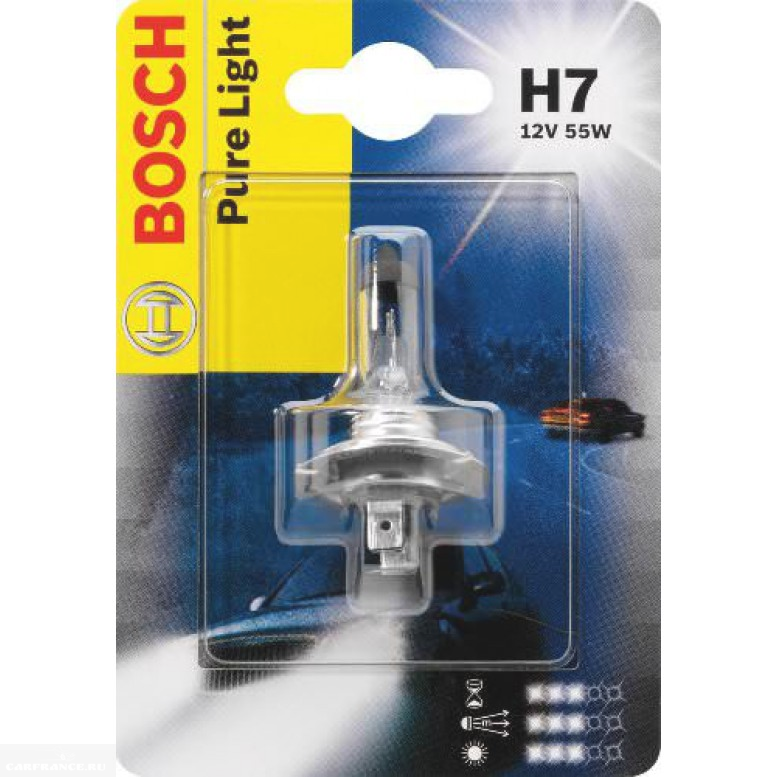
We emphasize that these are catalog numbers of replacement lamps for the standard dipped beam lamp. The model of the lamp can be chosen at your discretion and in accordance with your financial capabilities.. Now for the models.
Choosing a H7 lamp for low beam Focus 2
By design, any halogen lamp is similar to the usual “Ilyich light bulb” - it consists of a bulb (quartz or carbide glass), an incandescent filament that operates in an inert halogen gas environment.
The trouble with halogens is that they get very hot during operation and often burn out, unable to withstand temperature or vibration.
Therefore, we have an important requirement for the lamp - it must have a high resource and optimal luminous flux. Everything is clear with the color temperature - we do not consider collective-farm green, blue and purple dipped-beam lamps, since the light that is optimal for the eye is sunny with the appropriate color temperature.
Osram H7 Original
Osram H7 Original
The longest-lived lamp is Osram H7 Original. The manufacturer claims that the lamp can last at least 550 hours, while competitors give only 400 hours.. The warranty for the Osram H7 Original lamp is 350 hours, which is very good. German quality, German assembly, price within 450 rubles. The luminous flux is good, with second-generation Focus optics it works quite correctly.
Philips H7 Vision Plus
Philips H7 Vision Plus
One of the brightest lamps on the market in its price range. And it costs about 440 rubles. The Dutch claim that this lamp shines 60 percent better than other samples.. It may be true, but the Philips H7 Vision Plus works quite well by eye. The only negative is that it can burn out after 10-15 thousand.
Koito White Beam H7
Japanese good, expensive and bright lamp at a price of 1900 rubles per pair. This is about twice the price of Philips and Osram. What do you pay for then? It shines twice as brightly as a regular halogen. At least that's what the manufacturer says. Here you need to clearly understand that miracles do not happen, if the fire shines very brightly, it quickly burns out. It's the same with lamps. But Whitebeam has another trump card - a color temperature that is as close as possible to daylight (4200k). True, there is a minus here too - in the rain with such light you can not see a single light.
Koito White Beam H7
Hella H7
One of best performance according to the illumination of the far zone, a lamp from a sub-brand of the Philips company, Hella H7, issued. With a nominal illumination of 10 thousand cd, this lamp showed as much as 13,800 cd. True, the luminous flux is average, about 1400 lm, and the color temperature is far from daylight, 3300 K. For 2017, the lamp costs about 700 rubles.
We deliberately did not consider LED and xenon lamps, since their installation requires a complete reconstruction of the optics. Otherwise, the luminous flux will be uncorrected and the harm from such lamps will be more than good. Yes and good price LED lamp, for example, Cree MT-G2 with H7 base, a couple will exceed 5 thousand rubles. Choose the right lamps and good lighting for everyone!
Video about replacing low beam bulbs on Ford Focus 2
Any driver understands that good visibility in bad weather conditions is a critical factor on the road. Headlights play a key role here, and it is on them that comfort, confidence and, most importantly, traffic safety depend. Therefore, the problem of choosing lamps on the H7 base is quite acute.
Let's try to figure out what types of optics can be found in the automotive market, we will designate the main manufacturers of car lamps and give a list of the most successful and sought-after series, which included H7 lamps (low beam), distinguished by high-quality assembly and characteristics acceptable for domestic roads. When compiling the list, the opinions of experts in this field and the reviews of ordinary optics owners were taken into account.
Types of lamps
Many experienced motorists know that the optics of such a plan is divided into halogen, LED and xenon. Lamps (xenon) H7 are modern devices with good light output. They are minimally subject to any vibration, but have a couple of some critical drawbacks. The first is the installation of an additional ignition unit, and the second is too high a price compared to other types of optics.
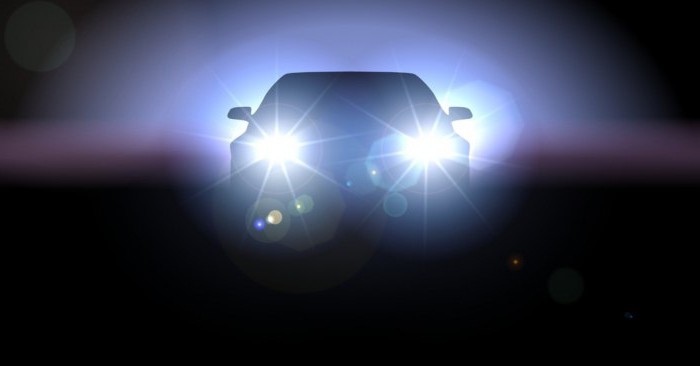
Based on the combination of available characteristics, LEDs are considered the best. Here we have environmental friendliness, good energy-saving performance and a fairly long service life. One of the most serious drawbacks of LED optics is the problems with light beam adjustment, especially in classic headlights. The price also cannot be called a plus of this type, so such lamps do not differ in popularity.
H7 is the most common and most affordable type of optics. Their most serious drawback is the high operating temperature with high heating, which leads to a significant reduction in the operational life and to the burnout of the main element. Among the advantages can be noted the cheapness of halogen optics and ease of adjustment.
We will not consider LED products due to their low popularity in Russia and fastidiousness. Below are the most good lamps H7 on halogen and xenon from venerable manufacturers.
PHILIPS Vision H7
The car lamp H7 from Philips of the Vision series is similar in its characteristics to standard optics, which are mounted on a factory conveyor. Products are distinguished by a slight increase in brightness in comparison with standard lamps and a pleasant white tint, a temperature of 3200 K.
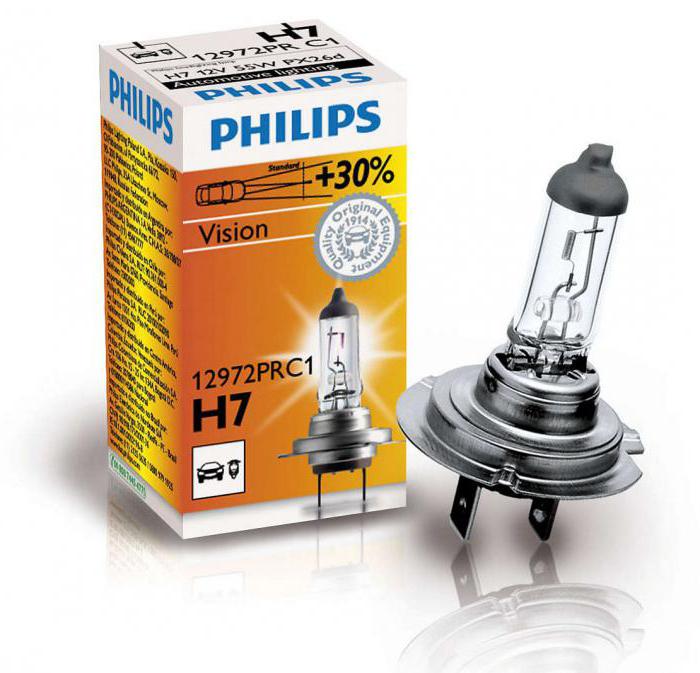
In addition, the series received a more than affordable price tag, as well as good performance strength, which is far from the last argument for the domestic consumer at the time of purchase. Car owners generally speak positively about Vision lamps from Philips. Users note not only an affordable price and high-quality assembly, but also a noticeably increased brightness, and not blinding oncoming drivers. Some owners complain about the blurry light border, but most halogen devices suffer from this drawback.
The estimated cost is about 300 rubles.
MTF-LIGHT LongLife Standart +30%
The South Korean lamp H7 has a brightness increased by 30% and a color temperature of 2900 K. In addition, the series received an improved filament, which significantly affected the service life of the products.
Among other high-quality budget representatives, this optics is the most inexpensive, which the domestic consumer could not help but notice. The owners speak quite warmly about this series. No serious shortcomings were identified, and the low price and available characteristics ensured this lamp an enviable popularity in our market.
Estimated price - about 250 rubles.
OSRAM Original Line
The H7 lamp of the Original Line series is a quality product from a reliable and popular German manufacturer. Optics received a good color temperature of 3200 K, which allows you to see the road surface in more detail. But in pursuit of kelvins, the service life of the lamp has noticeably decreased, so for those who travel very often in the dark, it is better to look for another option.
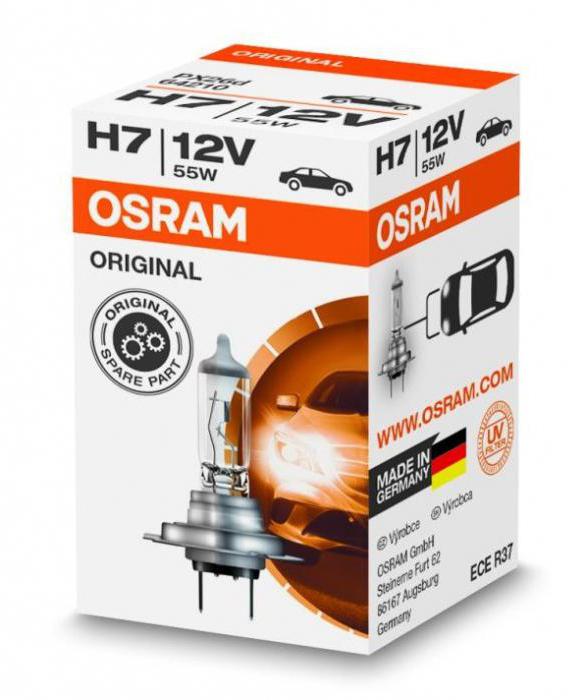
Car owners generally respond positively to the series. They noted a noticeably better color temperature and reliability of the entire structure in comparison with competitors. As for the service life, the average driver did not feel the difference between the Original Line and the same LongLife from MTF.
The estimated cost is about 400 rubles.
PHILIPS X-Treme Vision +130%
The H7 lamp from Philips of the X-Treme series is the brightest optics among other halogen counterparts. The device emits white glow with brightness increased by 130%, which gives an increase in the beam range by about 100-130 meters. In addition, a good color temperature of 3700 K allows you to see the road surface in detail.

The existing characteristics significantly simplify night driving for the owner of the lamps, but complicate it for oncoming drivers, blinding them. Therefore, it would be useful to adjust the luminous flux immediately after installing the lamps, because the basic settings are too aggressive.
Car owners speak positively about the X-Treme series from Philips. In addition to a powerful luminous flux and good color temperature, they appreciated the brand's customary lamp quality and a very long service life (up to 450 hours). Some complain about the cost of products, but experts note that the existing characteristics are balanced in terms of "price / quality".
Estimated price - about 1000 rubles.
MTF-LIGHT Argentum +80%
The H7 lamp from the Korean manufacturer of the Argentum series has more modest characteristics, unlike the previous respondent, but here we have a noticeably improved color temperature (4000 K), as well as a light beam in a specific silvery sheen, which looks very nice.
In addition, Argentum optics received additional protection glass, which is very important for our roads. The lamps have an increase in the light beam by 15 meters and increased brightness by 80% compared to the base one.
Car owners speak quite warmly about the Argentum series. Those who put them to replace the standard "halogen" do not get enough of a well-lit road with a large margin of visibility, but for the rest it is a good alternative to expensive xenon products.
Estimated cost - about 1000 rubles.
MTF-LIGHT with PHILIPS bulb
This xenon hybrid received the base from the “Korean” MTF-LIGHT, and the flask from the “German” Philips. This made it possible to significantly improve the main characteristics of the lamp, but at the same time the price of the product increased markedly.
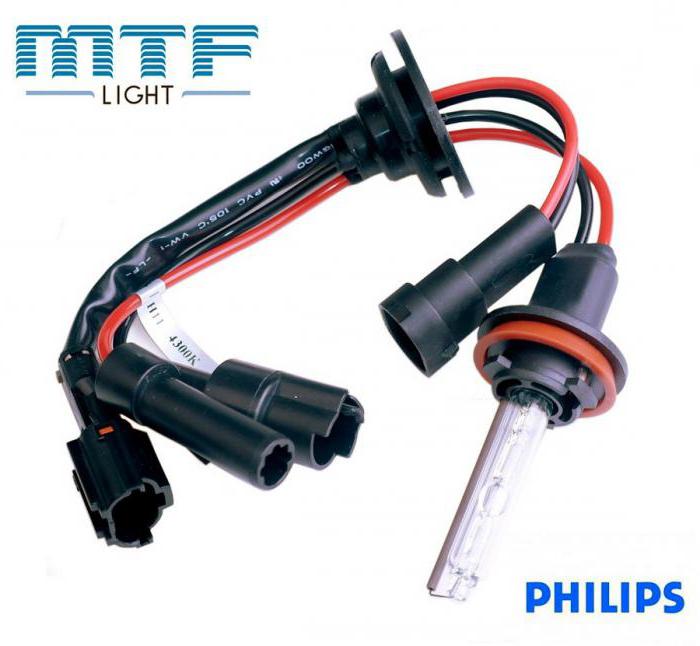
The choice of color temperature may be small (only 4300 K), like other analogues, but the brightness of 3200 lm is enough for excellent road lighting. In addition, the branded German flask significantly increases the service life of the entire structure, which pleases.
Users speak well of this hybrid. Car owners note the excellent illumination of the road with these lamps, the quick ignition of the product and good performance characteristics. Some complain about the price tag, but most understand that you have to pay dearly for quality.
Estimated price - about 2000 rubles.
SHO-ME H7 Xenon
A xenon lamp from a Chinese brand will be a good analogue of venerable European companies. Optics are affordable, but in our case this does not affect the quality as much as it happens with other products from the Middle Kingdom.

With its low power of 35 W, the lamp produces a bright beam of light at a glow temperature of 3000 to 6000 K. In addition, long service life (2000 hours), quick start-up, moisture resistance and resistance to mechanical damage make this optics extremely popular in the domestic market.
One of the critical disadvantages that users note in their reviews is the pickiness to reflectors, when some may start to smoke from the operation of these lamps. Otherwise, SHO-ME H7 Xenon is a great alternative to "halogen" and even some more noble products of venerable brands.
The estimated cost is about 500 rubles.
Summarizing
The choice of lamps on the H7 base is very large and diverse. Here, first of all, you need to decide what is more important to you: price, performance, brightness or color. Many make one unforgivable mistake for optics, chasing high power. It should be understood that standard wiring may simply not be designed for such a load, and the result is melted electrical elements or even worse: a car fire.
Replacing conventional "halogens" with similar ones is a simple matter and does not require any specific knowledge. But the installation of xenon optics is best left to professionals. Because incorrect installation, at best, will make you the “favorite” of traffic police officers, and at worst, it will burn all the electrical wiring in the car.
